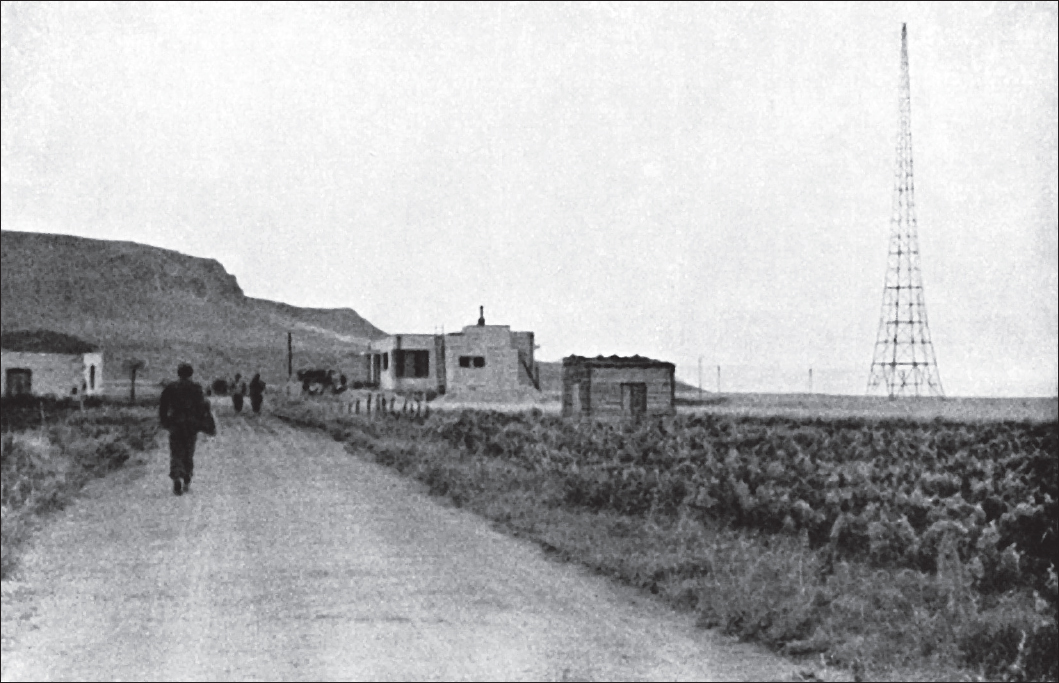
I./FschJgRgt.1 and the regiment’s HQ were dropped in the Gournes area, some nine kilometres east of the airfield. The 3./FschJgRgt.1 was the only company that dropped according to the schedule, as this company flew to Crete aboard the planes of K.G.z.b.V.107 (Hauptmann Wendorf), which took off from Tanagra. The I./FschJgRgt.1 HQ, under Major Walther – with 1./FschJgRgt.1 and 2./FschJgRgt.1 – followed after a three-hour delay. They were transported by K.G.z.b.V.60 (Major Hammer) from Topolia, where the backlog was quite significant. The 2./FschJgRgt.1 was supposed to jump two kilometres west of Gournes and occupy the radio station, but was dropped seven kilometres too far to the east and joined the rest of the battalion later that evening. The paratroopers who landed in Gournes occupied the radio station, which was in the area where after the war, an American base was established. The 4./FschJgRgt.1 was not dropped on Crete that day due to the lack of aircraft, and was later used in the Maleme sector with Gruppe West.

The radio station in Gournes; in the background can be seen Kopsas Hill, which dominates the landscape in the area. (G. Müller & F. Scheuering, Sprung über Kreta)
Map 3.1 The drop zones in the Gournes area, east of the airfield. (N. Panos, 2016)
The dispatch and the drop of the I./FschJgRgt.1 was organised as follows:
•The staff of the battalion, along with a signals platoon (seven officers and 56 NCOs and soldiers) in five planes, without losses
•1./FschJgRgt.1 (four officers and 113 NCOs and soldiers) in 10 planes instead of the planned 12, with the loss of one aircraft, which made an emergency landing on the island of Milos • 2./FschJgRgt.1 (four officers and 127 NCOs and soldiers) in 10 planes instead of 12, without losses
•3./FschJgRgt.1 (four officers and 116 NCOs and soldiers) in nine planes instead of 12, without losses
•4./FschJgRgt.1 did not drop that day, since only seven planes of the 12 needed were available
The terrain in the Gournes area is rocky in some places and not really suitable for paratroop landings; as a result, 15 men were injured during the jump – six of them seriously. During the drop and the initial assembly, the I./FschJgRgt.1 encountered only minor resistance from gendarmerie units and armed civilians from the nearby villages.
The dead on the first day were:
1./FschJgRgt.1
Objg Julius Bosse, 5 October 1919-20 May 1941
2./FschJgRgt.1
Gefr Kurt Kittendorf, 9 September 1921-20 May 1941
Gefr Kurt Martin, 18 November 1918-20 May 1941
Jäger Wilfried Timm, 4 November 1921-20 May 1941
Feldw Karl Traub, 24 September 1914-20 May 1941
3./FschJgRgt.1
Oblt Otto Friedrich, 26 March 1916-20 May 1941
Objg Heinz Gottschalk,1 9 October 1919-20 May 1941 (missing)
Paratrooper Gerhard Broder from the 2./FschJgRgt.1 described the drop:
The second wave started from the airfield between 15 and 16 hours. Between 16 and 17 hours we board our Ju-52. Graf von Blücher is the officer in command and he jumps first. I’m the fourth man. The Hauptfeldwebel, who keeps the company together, jumps as the last man. The planes that carry the company fly together in tight formation. From the window I observe tensely each plane and focus on every noise. My mouth is dry and the strong coffee only worsens the thirst and increases the heartbeat. We are not used to such a dose of caffeine. For the first time not all the weapons are dropped separately. The sub-machine-guns are fastened around our chests.
I see the Acropolis and draw it to the attention of a comrade but he waves it away and only swears something to himself. At sea the ships are already on the way to Crete but in fact they never managed to reach the island.2 It is already late and we are approaching our objective.
Gerhard Broder (left), with his fellow paratrooper Rudolf Jacobs, before boarding the Ju-52 for Crete. (Courtesy of Adrian Nisbett) Note: This was also the plane that Wolfgang Graf von Blücher travelled in.
The formation flies at very low altitude over the water. There, Crete emerges! I see the small island just before the coast. We fly eastwards over it, thus we are not going to jump at the originally planned spot. Now everything evolves very fast. ‘Get Ready!’ We check each other’s gear and we are ready for the jump. Graf Blücher is positioned at the door already. He looks tense. We fly over the coast then a honking signal sounds and Blücher forces himself away. We jump in very fast succession behind him.
My parachute is deployed and I hear the rattling of machine-guns and the shooting of snipers. No flak fire. Under me I see vineyards, olive trees and the coastal road. After only a few swings of the parachute I end up gently in the ditch of the coastal road, with the help of the evening upwind of the summer days. While still lying down I release the buckles of the harness and I see the weapons container approximately 30 metres away from me. The terrain is rocky and landing was dangerous. The planes make a wide turn and fly back to Greece without any losses. They have fulfilled their mission.
[…] Hauptfeldwebel Hermann Vogler, who should have jumped as the last man from the plane, did not and he has returned to Greece with the Ju-52. It is a unique case. It is said that his parachute was damaged but nobody can confirm this. He went through a court-martial and he was expelled from the paratroopers. Vogler was a sensitive man and a career soldier who always worked responsibly and behaved with dignity towards his subordinates. He was a really respected man.3
The drop of the HQ Company in the Gournes area, east of the airfield. The pictures were taken by Dr Günther Müller, who was an NCO in a medical unit of the FschJgRgt.1. The drop container shown in the picture belonged to Müller’s medical unit; the drop was conducted east of Kopsas Hill. (G. Müller & F. Scheuering, Sprung über Kreta)
Resistance by the Greeks grew stronger as time passed. Nikos Patatanes, from the village of Episkopi, described how the fighting began:
[...] The bombing and the blitz continued for the whole morning of 20 May until the time that the paratroopers began dropping. Along with my family I was in Episkopi where we heard that the paratroopers were falling in the Karteros valley, at the Kako Oros, at Kokkini Chani, Anopoli and Gouves. The master sergeant of the local Gendarmerie force in Episkopi addressed the crowd in the central square of the village [Agios Minas Square] and after a short patriotic speech he asked anyone who wanted to fight to follow him to Anopolis, where the battle against the Germans was underway.
We formed a group with Master Sergeant Antonios Fragakis in the lead along with Sergeant Vardis, and the civilians, Dimitrios Tsatsadakis, Panagiotis Mylonakis, Konstantinos Fouskokolakis, Nikolaos Papadakis and many others. We were virtually unarmed. We had only two old single-shot rifles, I had a knife and Fouskokolakis just a stick. We began for Anopolis but the master sergeant ordered us to pass by the English camp in Agios Romanos first, in order to ask for weapons. When we were approaching the camp, the English started shooting at us, why I never understood. Finally we arrived at the camp where an English sergeant told us to ask for guns from the Greek Army units which were deployed and fighting the Germans in the Karteros area. A villager from Elia warned us not to go to Karteros because the area was occupied by strong German forces, so we decided to go to Anopolis. When we arrived there it was already dark and the village was empty. There we met an old man and he told us that the Greeks had established themselves near the cemetery. After a while we joined them. There were two decimated platoons under 2nd Lieutenant Vasilios Galenianos and a sergeant. They were very happy to see us there. ‘We do not have any spare weapons to give you but we can take some from the Germans,’ they told us. This was what exactly happened the next morning when dozens of German troop-carriers arrived and started dropping paratroopers and supplies in Kokkini Chani. The paratroopers were using mortars and machine-guns and bitter fighting began at Kopsas Hill. More paratroopers dropped in the area and with their machine-guns they were shooting at everything that was moving. They were caught by surprise because they didn’t expect such a resistance. The battle was even and lethal. Emmanuel Kokkinakis from Anopolis was killed when he rushed the Germans, crying ‘AERAA!4 On them! We got them!’
The losses were heavy on both sides. About 705 German and 17 Greeks were killed while many others were wounded or captured. When things calmed down, I moved a bit further to find cigarettes and I saw a wounded paratrooper trying to dress his wounds, holding one edge of the field dressing with his teeth. I felt sorry for him and I went close to help him. When he saw me he kicked me and tried to reach his gun while pressing his arm on my throat trying to strangle me. We started wrestling and then I stabbed him a few times with my knife. I then took his gear and threw it into the bushes. I was afraid of reprisals and during the night I took the gear and hid it very carefully. The next day I reported the incident to the 2nd lieutenant and he admonished me, saying that if I had been killed nobody could have known what had happened to me.
The fight went on and we were all shooting together. The area was full of corpses when we handed over the prisoners to the Greek authorities in Episkopi for interrogation. After the battle, the Germans retreated eastwards, to Gouves. The news about the German losses raised our spirits and the villagers from the nearby villages supported the fighters by supplying food and water.6
Oberst Bräuer arrived in Gournes with the FschJgRgt.1 HQ at around 1840.7 Immediately after his landing, about 800 metres east of the radio station, Bräuer was briefed about the situation by Major Walther. Bräuer decided to move westwards to the airfield without having contact with the rest of the units, which had been dropped around the airfield and west of the city. The main priority at that time was to get in contact with Hauptmann Burckhardt’s II./FschJgRgt.1, which had been dropped around the airfield.

A dead paratrooper in the area west of Kopsas Hill, where Nikos Patatanes described the action. (Author’s archive)

The same location today, with Kopsas in the background. (Author’s collection)
Bruno Bräuer was a First World War veteran, a career officer and one of the pioneers of the German paratroopers. He was tough and decisive, and had proved his skills and bravery in battle, so winning the respect and admiration of his men.
Two years after the battle – and now a general – Bräuer assumed duties as the commander of Fortress Crete. After the war, he was convicted and sentenced to death by a Greek court for war crimes committed during the German occupation of the island. He was executed along with General Müller (also a former commander of Crete) ironically on 20 May 1947: the sixth anniversary of the invasion. As such, he was the last victim of the Battle of Crete and was buried along with his comrades. His grave today is at the German war cemetery in Maleme.
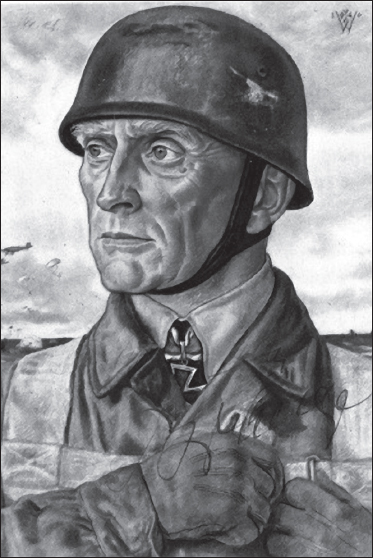
Oberst Bruno Bräuer in a wartime postcard. (Author’s collection)
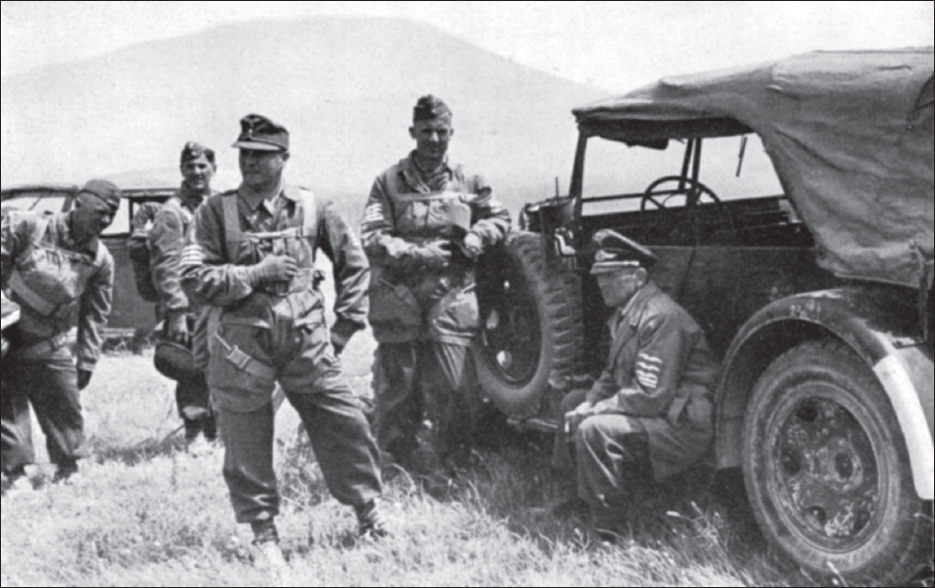
Bräuer sitting on a vehicle and patiently awaiting his turn to board the Ju-52 for Crete with his adjutant, Hauptmann Rau. (G. Müller & F. Scheuering, Sprung über Kreta)
Oberst Bräuer in the Ju-52 on the way to Crete. (G. Müller & F. Scheuering, Sprung über Kreta)

The announcement of the execution of Bräuer and Müller at the Greek military camp in Chaidary on 20 May 1947. (Courtesy of DDF)
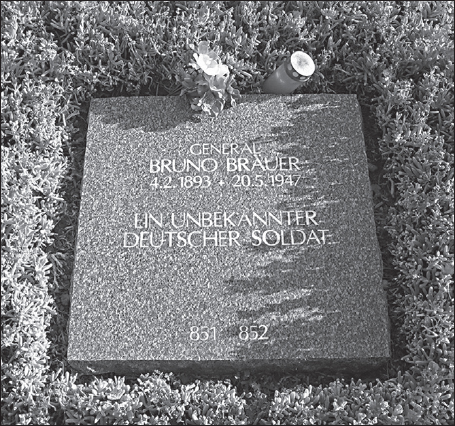
Bräuer’s grave (No.851) in Maleme at the famous Hill 107, next to the airfield. (Author’s collection)

Kurt Student laying a wreath in 1957 in memory of Bräuer and the other fallen fallschirmjäger. (Courtesy of DDF)
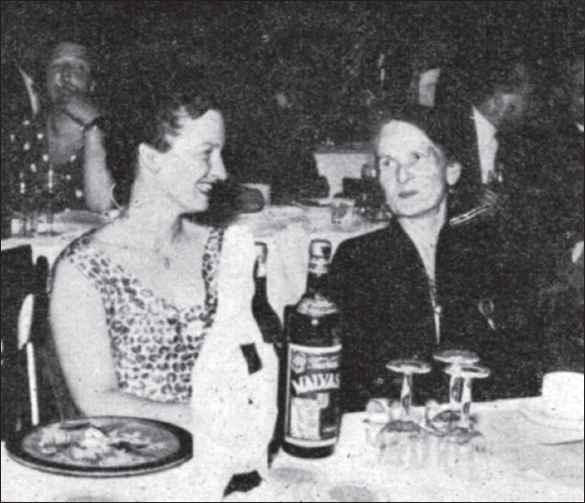
Mrs Bräuer (on the right) at a veterans’ gathering in Bochum in 1957. (Courtesy of DDF)
Dr Günther Müller described the moment of his jump:
[...] At last I feel that I’m ready and through the noise of the engines which sound like a hammer in my head, I hear a voice call ‘Rush to the enemy! Rush to the enemy!’ We were probably in flight for two hours before we saw Crete. The rocky coast of the island can be barely seen, blurred in the distance. We bypass the small island of Dia on purpose since we suspect that there are AA guns there. We hear a voice from the cockpit shout ‘GET READY!’ and everything comes to life in the plane. We take off the life-vests, and hook the static lines on the wire, checking each other’s gear and parachutes.
Tension and absolute silence prevails! I see tough and decisive faces. ‘GET READY FOR THE JUMP.’ That was it! With these thoughts in my mind I stand in front of the door. The waves are splashing on the rocks below and then we are over a vineyard. This is very good since we can find cover there if needed. I can’t see anything else. The air brings tears to my eyes and pushes me hard. I bend over like a cat and I’m pressed onto the left side of the door. Because of the noise of the engines I can’t hear the signal to jump but suddenly I feel a push on the side from my comrade behind me and I already see the plane moving away. Damn it! This time the parachute deployment was delayed for too long, I’m thinking while I’m falling. Then a ‘giant hand’ grabs me and pulls me up. The harness holds me tight as I’m hanging from the parachute.
Everywhere I see comrades descending under their parachutes. I’m heading towards a shed in a vineyard and I have a grenade ready to use, holding the porcelain ball in my hand. The noise of an explosion comes through my body as I see my commander. I’m thinking that he will have already cleared and secured the area. When one jumps by parachute into battle one goes into the unknown and uncertainty, but all the paratroopers are in the same position, from the general to the corporal. I land very hard next to the shed into the vineyard. I learned later that the explosion came from a drop-container that crashed violently to the ground because the parachute had failed. This day hundreds of comrades jumped from the aircraft. The Fallschirmjäger attacked Crete!8
Since 19 May, Lieutenant Theodoros E. Kallinos (Greek Army) – leading a force of approximately 150 men – had been established on Kako Oros Hill, between Kopsas and the airfield. At the beginning of the drops on Gournes, Kallinos realised that it would be better to occupy the top of Kopsas, right next to the drop zone in Gournes – so putting the paratroopers within range of his weapons. Moreover, the hard and rocky surface of the Kako Oros didn’t allow his men to dig in and prepare appropriate defensive positions.
During the afternoon of 20 May, Kallinos and 70 of his men moved very quickly and occupied the top of Kopsas, where they posed a serious threat to the Germans on their drop zone. Kallinos’ men established their defensive positions with the front towards Gournes and to the coast. Their only machine gun was an old 1915 model, and quite soon it was jammed – rendering it useless. Without the support of a machine gun, the Greek soldiers could only rely on their rifles and hand grenades in order to fight an enemy with vastly superior firepower.
The steep and rocky slopes of Kopsas actually compensated for the Greeks’ lack of firepower: a platoon of the 1./FschJgRgt.1, under Leutnant Boris Lindenberg, was assigned the task of protecting the paratroopers’ left (southern) flank from the Greek forces in Kopsas and the hills south of Gournes. At around 0530 on 21 May, the paratroopers took advantage of the darkness and advanced to the foothills of Kopsas – and there they took up their start positions for an assault.
Oberst Bräuer, immediately after his landing in Gournes, conferring with Major Walther (centre) and the adjutant of I./FschJgRgt.1, Leutnant Schulz (right). This photo was taken by Dr Günther Müller – the author of the book Sprung über Kreta. (G. Müller & F. Scheuering, Sprung über Kreta)
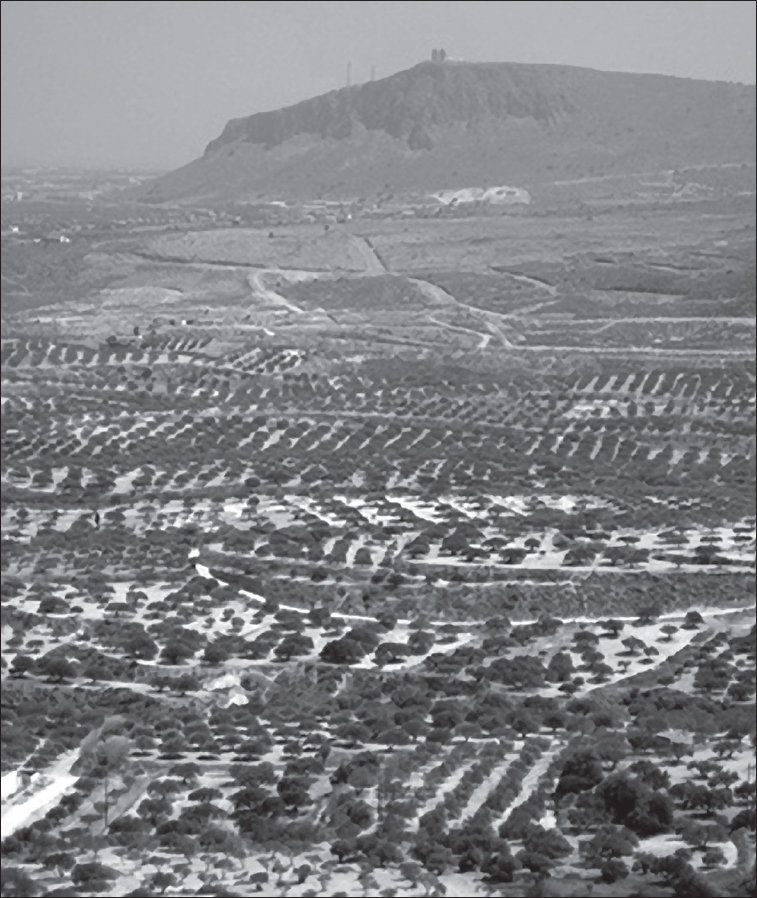
The same area today. In the background is the hill east of Kopsas – providing good evidence for the exact drop zone of the I./FschJgRgt.1 and the HQ Company. (Author’s collection)
Erich Walther (5 August 1903-26 December 1947) joined the Berlin Police in 1924. After serving in the ‘General Göring’ Regiment, he was promoted to hauptmann and transferred to the fallschirmjäger – following the same path as many of the German paratrooper pioneers. He participated in the operations in Holland and Norway with FschJgRgt.1, where he distinguished himself by his decisiveness in action, and was awarded the Knight’s Cross. Subsequently, he was promoted to major on 19 June 1940.
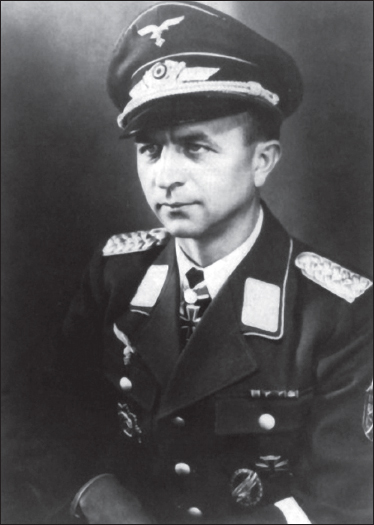
Erich Walther in a late-war photograph. (Courtesy of Wolf Walther)
In May 1941, he fought in the Battle of Crete – in the area east of Heraklion – as the CO of the I./FschJgRgt.1. After the battle, he served on the Eastern Front in the Leningrad area, where he was awarded the German Cross in Gold. In August 1942, Walther was promoted to oberst and in September, he assumed command of the FschJgRgt.4. He participated in the fighting on Sicily and at Monte Cassino.
In the Battles of Nijmegen and Arnhem, during the famous Allied Operation ‘Market Garden’, he was the CO of the ‘Walther’ Battle Group. Later, he assumed command of the paratrooper units belonging to the 2nd Armoured Brigade, ‘Hermann Göring’ in Eastern Prussia – and on 30 January 1945, he was promoted to generalmajor.
On 8 May 1945, he was captured by the Soviets and died in captivity in the POW camp at Buchenwald on 26 December 1947. Walther had been awarded the following decorations: Iron Cross (2nd Class 18 April 1940 and 1st Class 26 April 1940), Knight’s Cross (24 May 1940), German Cross in Gold (31 March 1942), the 411th Oak Leaves (2 March 1944) and the 131st Swords to the Knight’s Cross (1 February 1945).
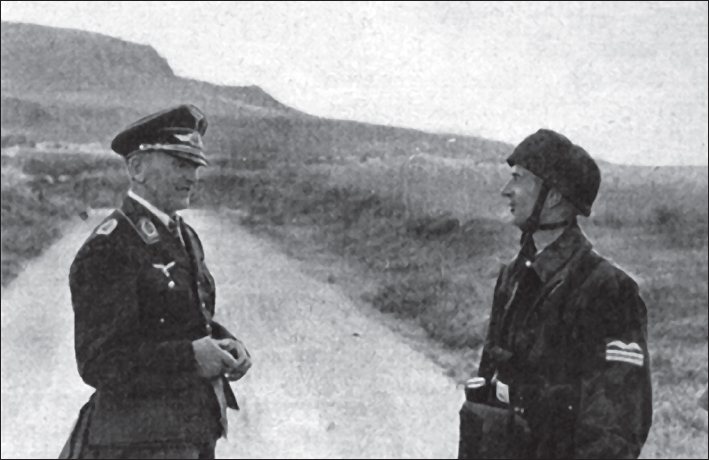
Major Walther with Oberst Bräuer in Gournes, standing in front of Kopsas Hill. (Courtesy of DDF)
Under the cover of a machine gun barrage, they attacked both from the north and the east; in fact, they took the defenders on the east of Kopsas by surprise, as they had never expected an attack up such a steep slope. The paratroopers followed an old track that was used by the local shepherds – managing to reach the top of Kopsas from the east and then suddenly appearing right in the middle of the Greek defensive positions. Chief petty officer Nikolaos Koukovinos’ platoon, which was positioned lower on the northern slope, was very quickly surrounded and captured by the Germans. Having been totally surprised by the unexpected attack from the east, the remaining Greeks were forced to retreat to the south towards the church of Prophitis Elias. Realising that this was a turning point in the battle, Kallinos took a chance and, leading his men with his revolver in hand, attacked the Germans just 50 metres in front of his position. The Germans did not expect this counter-attack and they found themselves in a very difficult position – being outnumbered and isolated between the cliff and the attacking Greeks. Moving rapidly to the right of Kallinos, a Greek sergeant from Dodecanese started throwing hand grenades at the paratroopers’ most forward positions; they were forced to retreat – leaving guns and ammunition behind – and releasing the Greek prisoners. The unexpected success of this counter-attack raised the spirit of the Greeks, who immediately charged the paratroopers and ended up in close combat with them. About 10 Germans were killed, 9 while the rest were taken prisoner. The Greeks only had one seriously (Dimitrios Liakakis) and another slightly wounded (Private Ioannis Chatzis).
When the fight was finally over, Kallinos noticed that some signal flares were coming from a small building on the road east of Kopsas. This was Andreas Mavrakis’ house, which was located on the main road to the east and not far from the radio station. A group of paratroopers had been trapped there and were trying to indicate their position and call for reinforcements. Kallinos ordered Sergeant Orestis Andreadakis and a group of soldiers to advance downhill to the east slope of Kopsas and wait there for further instructions. Along with the soldiers, many armed civilians had gathered and were participating in the fight. Contrary to his orders, Andreadakis decided to attack immediately, but his assault failed, as the paratroopers were very well protected in the small house. During the conflict, Andreadakis himself was killed, as were Emmanuel Kokkinakis and Ioannis Charitakis. When Kallinos was informed of the loss of his men, he decided to take revenge at any cost. He moved covertly along the west side of Kopsas and positioned a captured German machine gun approximately 300 metres away from the house. During this move, the machine gunner was shot at and injured by the Germans, but he remained at his post. Kallinos ordered his machine gunner to fire short bursts successively at the two windows and the door of the house. Twenty minutes later, a white flag appeared in one of the windows and thick smoke was seen coming from the building. The tracer rounds had ignited sacks filled with sulphur, which had been stored in the building for use in the vineyards. Seventeen paratroopers emerged from the house and surrendered – thus avoiding suffocation from the thick smoke.
Nikos Patatanes remembered:
We were ordered to move downhill very carefully and we established ourselves at the area where later the American base was built right next to the radio station. There we realised that some of the Germans had moved eastwards and occupied the house of Andreas Mavrakis [with nickname ‘Katsikis’] where sacks with sulphur for the vineyards were stored. We moved forward very carefully and we surrounded the house which was built of bricks. The house was surrounded by vineyards and we couldn’t find any good cover. The fight lasted for quite some time but we couldn’t reach the house because of the heavy gunfire coming from inside. We thought that this would be a long fight but suddenly at around 6:00 pm the door opened and a white flag appeared. We rushed to the house and the Germans started coming out almost blinded by the smoke, while some of them were injured and were asking for medical treatment. We transferred them to the hospital in Episkopi where the doctors treated their wounds. In this fight Yannis Chatzis from Anopolis was seriously wounded, while two of our comrades, Spyridakis and Aretakis from Gouves were killed. I also remember that Antonios Liapakis from Anopolis fought in this battle. We then returned to Prophitis Elias and we were really hungry and thirsty. The sergeant went to the monastery of Agios Ioannis where the monks provided him with food. The next morning we moved southwards to regroup and continue our struggle and resistance.10

The area east of Kopsas, with the house where the paratroopers were trapped, right next to the road and the vineyards. (Author’s archive)
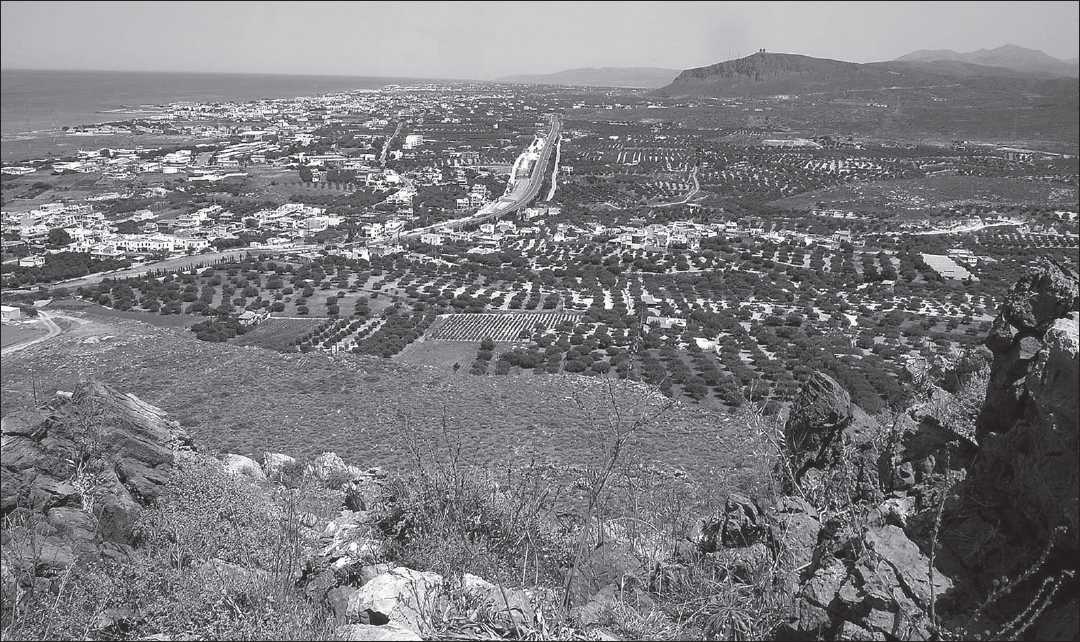
The view to the east from the top of Kopsas. The paratroopers managed to cross the plateau unnoticed under the cover of darkness and then climbed the steep slope – taking Kallinos’ men by surprise. (Courtesy of C.E. Mamalakis)
As a result of this action, by the evening of 21 May, there were no German strongholds left in the Gournes area.
According to the German after-action report, 11 Major Walther received the order (at approximately 2340 on 20 May) to pull together his scattered battalion and march in the direction of the airport. Communicating this order at night to companies spread out to the east and the south took a long time. A platoon of the 1st Company, under Leutnant Lindenberg, could not be found. Lindenberg – in contravention of his orders – had advanced into the mountains to the south of Gournes and, as was discovered later, was attacked by Greek troops. Many of Lindenberg’s men were killed, while the rest were taken prisoner. Lindenberg had been severely wounded and was transferred by the Greeks to Episkopi, where a Greek nurse treated his wounds; however, he died on 23 May and was buried in the local cemetery. The people of Episkopi, near Gournes, still remember this incident and describe Lindenberg as a very tall and strong man. During the next day of the battle, villagers from Anopolis and Episkopi buried the dead paratroopers in makeshift graves.
Evangelos Vardakis from Episkopi recalled:
In my village, Episkopi, the English had established a field hospital. They were providing treatment to the wounded, both Allied and German. After treatment, the wounded were transferred to the Archangel Michael Church to recover. A gendarmerie sergeant named Vardis was carrying the wounded on his back – having also two machine guns hanging from his shoulders and a Luger pistol in his belt. At one point, he carried a wounded German officer12 who was a tall man with his body full of buckshot.13 He was shot with a shotgun or a hunting gun. The German was put on a bed in Emmanouel Antonakakis’ house [Antonakakis was a teacher]. A couple of days later, the German was transferred to the church, where he died. He was buried at the local cemetery by Antonakakis and Noikokirakis, with the help of Hatziioannou and Katergianakis. Zacharias Roditakis, a carpenter, made a wooden cross and placed it on the grave, while a nurse named Mourmouri wrote the name of the German on the cross. Some days later, a German truck – escorted by two motorcycles with side cars – arrived at the cemetery. After questioning the villagers, the Germans had lunch at the house of Antonakakis and then they recovered the bodies of the paratroopers.14
On 29 May, when the battle was over and the Germans were investigating what had happened to Lindenberg’s men, the villagers led the investigators to the graves, where they recovered the bodies.
Even today, many cartridges can be found in the Greek positions at the top of Kopsas. (Courtesy of C.E. Mamalakis)

Kako Oros Hill, as seen from the top of Kopsas, and a closer view from the coastal road, which the paratroopers of the I./FschJgRgt.1 followed after their drop in order to approach the airfield. (Author’s collection)
Map 3.2 The positions and the movement of the adversaries during the battle on Kopsas. (N. Panos, 2016)
The grave of Leutnant Lindenberg at the Episkopi cemetery, next to Agioi Apostoloi Church. (Courtesy of Steffen Rhode)
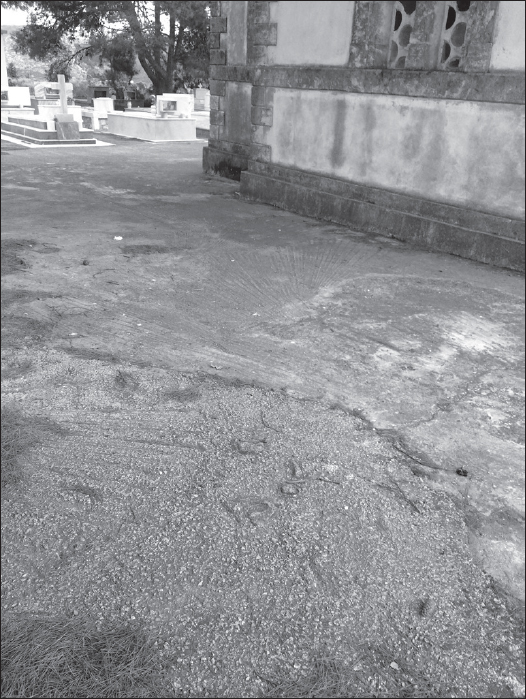
The same place today, with a corner of the church visible in the background. (Courtesy of C.E. Mamalakis)
Paratrooper Gerhard Broder from the 2./FschJgRgt.1 observed:
A platoon is ordered to take retaliatory action against civilians for the murder of the wounded. A lorry departs full of heavily-armed soldiers with Oberleutnant Otto in command. The destination is a mountainous village called ‘Gournes’. This place has a reputation of being a nest of partisans. I do not know who gave the order and what exactly their instructions are, but I can imagine what is possible when revenge and punishment become legal military actions. I’m glad that I do not participate in this mission. After some hours the platoon returns and I sit with my comrades. I ask them what happened. Amazed and relieved I hear: ‘Nothing!’ After a long conversation with the local authorities in the village of Gournes we realised that there weren’t any partisans or murderers there. Oberleutnant Otto decided not to take any action against the population of this village.15
At the top of Kopsas, there is a big cross – placed there by the Americans in the 1960s. According to some accounts, the cross was erected by the German wife of an American officer from the Gournes base. At the base of the cross, there was a plaque with the names of the dead Germans.
The cross at the top of Kopsas, which was placed by Americans from the military base in Gournes in the 1960s. (Author’s archive)
According to the German archives, the losses of the 1./FschJgRgt.1 on 21 May (most of them killed on Kopsas) were the following:
Objg Egon Bartel, 28 September 1920-21 May 1941
Jäger Hans Joachim Graf von Blücher, 23 October 1923-21 May 1941 (killed at Karteros, near the airfield)
Gefr Heinz Bock, 16 March 1914-21 May 1941
Gefr Kurt Kilgus, 20 April 1920-21 May 1941
Ltn Boris Lindenberg, 20 January 1918-21 May 1941
Jäger Hans Meyer, 3 April 1921-21 May 1941 (killed at Karteros, near the airfield)
Gefr Friedrich Robitzeck, 10 October 1920-21 May 1941
Obgfr Wilhelm Skrandis, 26 July 1913-21 May 1941
Gefr Hans Scheps, 23 September 1918-21 May 1941 (killed at Karteros, near the airfield)
Objg Hermann Veit, 20 June 1919-21 May 1941
Oblt Albert Wittmann, 8 October 1915-21 May 1941 (killed at Karteros, near the airfield)
Gefr Hans Ziesing, 5 March 1921-21 May 1941(most probably killed at Karteros, near the airfield)
Bock and Skrandis are buried in the same grave (No.961), along with Gefr Arthur Amenda from 3./FschJgRgt.1. Bartel, Veit and Robitzeck are also buried in the same grave (No.964); these are the men that were killed in Kopsas and buried by the Greeks.
1 Heinz Gottschalk fell during the Battle of Crete, but his remains were not recovered. According to the BDF Archives, he fell into the sea. His name is recorded at the war cemetery in Maleme.
2 He refers to the convoys of boats loaded with German troops, which were intercepted and destroyed by the British fleet.
3 G. Broder, Guerre Mondiale Contre Moi, pp.85”95.
4 The war-cry used by the Greeks during the Second World War.
5 The number of German losses are probably a personal estimation by Mr Patatanes and cannot be confirmed. The total German losses in this area were 20-25 dead and many more wounded or taken prisoner, which is in agreement with the German records and the official Greek accounts.
6 M. Liapaki-Antonaki, ‘Chronicle of the Battle of Kopsas, 24 May in Anopolis Pediados’, Heraklion, PATRIS newspaper, 24 May 2003; available online at <http://www.patris.gr/articles/9028?PHPSESSID=#.VWwIh8-qqko>
7 German time.
8 G. Müller & F. Scheuering, Sprung über Kreta, pp.47”51.
9 According to the German archives, the remains of 17 paratroopers were collected from the area of Kopsas after the war and were transferred to the Maleme Cemetery. This number also includes the paratroopers killed during the drop.
10 Liapaki-Antonaki, PATRIS newspaper, 24 May 2003.
11 XI Fliegerkorps, Gefechtsbericht ‘Einsatz KRETA’, p.7.
12Leutnant Boris Lindenberg.
13 Lindenberg, while leading the attack against the men of Kallinos at the top of Kopsas, was most probably injured by the shrapnel from the grenades that the Greeks threw at the paratroopers. As a result, Lindenberg’s body was riddled with shrapnel, which could have been mistaken for buckshot by the people who carried him.
14 Interview with C.E. Mamalakis in Heraklion, 10 December 2015.